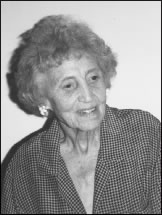By Albert Amateau
Margot Gayle, one of the city’s most successful preservation advocates, who mobilized the Village to save the Jefferson Market Courthouse and spearheaded the preservation of the Soho Cast-Iron Historic district, died at home Sun., Sept. 28, a few months after her 100th birthday.
With a mixture of tact and tenacity, she was able to convince neighbors and political leaders to join in the preservation of the built environment. Among her collaborators in preservation efforts were such renowned Villagers as the late Jane Jacobs, Ruth and Philip Wittenberg and Tony Dapolito.
She was a tireless organizer, a founder of the Village Neighborhood Committee, the Victorian Society in America and the Friends of Cast-Iron Architecture.
“She wrote hundreds of postcards thanking anyone who did anything,” recalled Hilda Regier, a longtime member of the Victorian Society in America. “Those gracious touches were a big part of her ability to organize people.”
“The Soho Cast-Iron District was Margot’s district. It was her idea and she would always ask me, ‘So when are we going to get the rest of the cast-iron buildings?’” recalled Simeon Bankoff, director of the Historic Districts Council.
The 26-block Soho district, between Houston and Canal Sts. from West Broadway to Crosby St. was designated by the Landmarks Preservation Commission in 1973, but Gayle had been lobbying to expand the district to cover buildings on the west side of West Broadway and the east side of Crosby St.
In a 1996 oral history interview for the Greenwich Village Society for Historic Preservation conducted by Laura Hansen, Gayle recalled the efforts that began in the mid-1950s to preserve the vacant 1877 Jefferson Market Courthouse a.k.a. “Old Jeff” at the angle between Greenwich and Sixth Aves.
Gayle recalled her involvement in Democratic Party Reform politics, her work for the then city Department of Commerce and Public Events and later for the City Planning Commission and the access that those activities gave her to public officials like Mayor Robert Wagner.
“I would say, ‘What can we do about the Jefferson Market Courthouse? I hope you’ll help me.’ And [Wagner] would look at me as if to say, ‘Don’t talk to me now, I’ve got to make a speech or introduce this or that dignitary.’ I was kind of naive on that score and not very sensitive,” she told Hansen.
Nevertheless, the city dropped the plan to sell the historic property, the clock tower was saved and preservationists went on to convince the city to install a library in the building.
She was born Sarah Margaret McCoy, in Kansas City, Mo. Her father was in the automobile business and her grandfather, Joseph McCoy, built the stockyards at Abilene, Kan., where the Chisholm Trail Texas-to-Kansas cattle drives ended.
The family moved around and Sarah Margaret adopted the French name, Margot, in high school in Windsor, Ontario. She graduated from the University of Michigan in 1930 and went to Atlanta, Ga., where she got a job as a social worker and married William T. Gayle, Jr., in 1932. She studied bacteriology at Emory University and earned a master’s degree in 1933.
In the mid-1930s she joined efforts by the League of Women Voters in Atlanta to eliminate the poll tax.
“It was a passion,” she told Hansen in the 1996 interview. “I was introduced to it by Josephine Wilkins.… She was Georgia State president of the League of Women Voters. She imbued me with a feeling that nothing could be more un-American, more unfair, more undemocratic than requiring that a tax be paid before one could vote,” she said.
At the beginning of World War II while her husband was in the Army, Gayle became director of the Civil Defense Volunteer Office in Washington, D.C., and in 1945 she moved to New York and rented a top-floor apartment in an 1830 house on King St.
“My husband and I had a deal that when he got back from the Army, we would try to be in New York. I ended up in the Village just because I had to find a place to live,” she told Hansen.
She joined a summer radio-writing workshop and eventually became a scriptwriter for CBS. It was as a scriptwriter that she became interested in big public clocks.
“There was a clock on St. Peter’s Church in Chelsea that I wrote into a radio show,” Gayle recalled to Hansen.
In 1953, Gayle was hired as public-relations director for the city Department of Commerce and became involved in Democratic Party affairs as a state committeewoman and a Manhattan district leader. She and her husband divorced in 1957.
From 1956 to 1958 Gayle was the public information officer of the City Planning Commission. She ran — unsuccessfully — for the New York City Council in 1957.
Two years later, she organized the Village Committee to Save the Jefferson Market Courthouse.
Gayle told Hansen that she was inspired to save the courthouse by Alan Burnham of the Municipal Art Society. Burnham later was a member of the city’s Landmarks Preservation Commission.
By 1961, the courthouse’s preservation was assured, and in 1965 Gayle was among the people who helped create the Landmarks Preservation Commission after the demolition of Penn Station.
Gayle turned her attention next to cast-iron buildings in 1968 after she heard a lecture on the subject at the Municipal Art Society. In 1970, she founded the Friends of Cast-Iron Architecture, and by 1973 the Soho district was designated.
From 1975 to 1992, Gayle wrote the “Changing Scene” column for the New York Daily News Sunday Magazine.
She also lived on W. Ninth St. and moved to the Upper East Side about 20 years ago.
Although the Soho Cast-Iron District’s extension remained an unfulfilled dream of Gayle’s, preservation advocates still hope the Soho district extension will happen soon.
Gayle is survived by two daughters, Carol Gayle, of Lake Forest, Ill., and Gretchen Gayle Ellsworth, of Washington, D.C., six grandchildren and seven great grandchildren.































